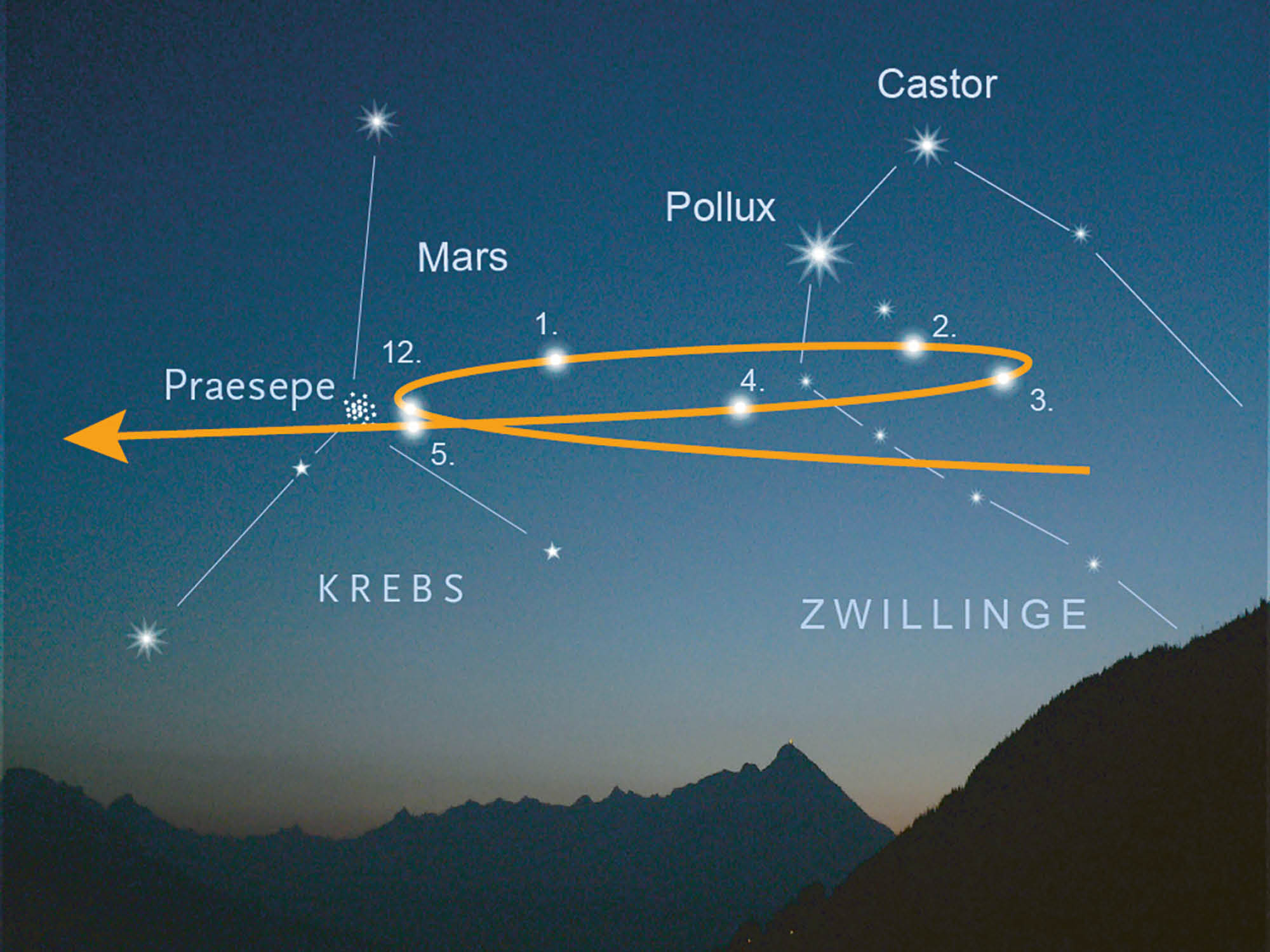This year, at Christmas time and again at Easter, Mars passes through the cosmic place of incarnation to inspire the will.
The arc of the sun reached its lowest position for the northern hemisphere on the winter solstice, December 21st. However, if you are an observer of twilight, you might have noticed that the earliest sunset was on December 6th, and the sun actually set a few minutes later on December 21st. Why is this? The reason has to do with the earth’s elliptical orbit, so that the true length of day during the Christmas season is just over 24 hours. Conversely, the latest sunrise was not on December 21st, but at the beginning of January. The result: in the northern hemisphere, the “longest night” is only mathematically set on the day of the winter solstice—in reality, it starts with the earliest dusk at the beginning of December and ends with the latest dawn at the beginning of January. The greatest darkness of the year extends over an entire month.
Light in the Darkness
Light shines three times into this darkness. In the late evening hours, all ten of the brightest stars visible from the northern hemisphere are gathered together. It is a silent fireworks display of light. In addition, we have the meteor showers: the Geminids (from the direction of Gemini) at the beginning of December and the Bootids (from the direction of Bootes) at the beginning of January.
The zodiacal sign of Sagittarius offers invisible light. During the Holy Nights, from December 24th to January 6th, the sun moves through a bright field of stars like at no other time of the year—the stars of Sagittarius. What an image for the northern hemisphere: the sun is at its lowest, the life of the earth rests, and at the same time, the sun is surrounded by a crown of stars as an image of spiritual light.
A gap in time opens up for this spiritual light. Twelve full moon cycles of 29.5 days each add up to 354 days, while the sun needs 365.25 days to complete its course. This leaves it with 11.25 days or twelve nights “alone’”—a purely solar effect. This play of bright stars, shooting stars, and winter sun happens every year. The position of the planets is different, however, and so they give each Christmas a unique cosmic seal.
Mars Connects Birth and Death
This year, it is Earth’s neighbor Mars: it is close to Earth and therefore shines all night long. A red glow in the sea of otherwise cool shining stars and planets, the red planet has been in a prominent position in the zodiac for the entire Advent season. The planet of will is sitting at the point where the three lines of light in the image converge to a diffuse center in the constellation of Cancer. Nowhere else in the zodiac does such a centre—an energy place of identity and of unity—form, as in the cluster of stars at the centre of Cancer. In ancient times, it was said that this is where souls come into time on their pre-natal journey. Praesepe (the Crèche or the Beehive Cluster) is still the name of this stellar birthplace today.
It is interesting that Mars stood still here at the beginning of December and then began its retrograde on December 7th. Over the next two months, its path leads back to Gemini, and then it returns to the center in Cancer in March, reaching this place of incarnation again during Easter time. Mars thus connects Christmas and Easter. Birth is certainly the greatest will event in life, so Mars in Praesepe is already a Christmas event. But now, Mars in Praesepe repeats at Easter. This sheds further light on this constellation. In fact, the will is not only an incarnation event, but also an event of Easter’s “die and become.” One’s own will becomes holy when it emerges from self-knowledge, from inner death and inner transformation. This is the will that develops beyond self-interest. Anyone who observes such will can confirm that these deeds are a great blessing for this world, but are not entirely of this world. Mars seems to be calling for such a heavenly will this year.
Love, Deep and Wide
An impressive constellation at the beginning of the new year shows how this greater, deeper will could succeed. For months, Venus has been glowing in the evening sky near the western horizon. On January 19th, Saturn, the planet of inwardness and maturity, will be close to the planet of love with the stars of Aquarius shimmering in the background. Saturn, the most distant and peaceful wanderer, gives the planet of love depth and maturity. Aquarius’ contribution can be read from the star formation in this image. At the top, in the middle of this constellation, four stars create a wave-like line. Other stars allow this wave to flow to the right, over Capricorn, and down, far below the zodiac line. Aquarius thus represents expansiveness, a vastness that the image itself creates. Aquarius gives Venus breadth. This is the language of heaven that begins the new year: the will becomes heavenly when love becomes deep and wide. Heavenly will becomes earthly when its birth becomes paschal, passes through death, rises, and is reborn.
Translation Laura Liska
Image Mars moving between Cancer (Krebs) and Gemini (Zwillinge). Source: Sternkalender 2025/26









